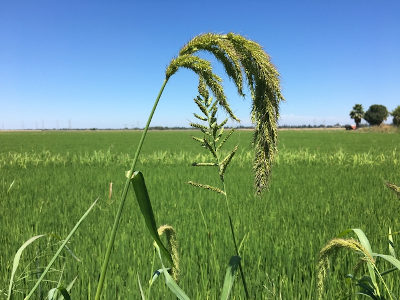By Michelle Leinfelder-Miles
- Prevention (e.g. using certified seed, equipment sanitation, maintaining roads and levees)
- Cultural practices (e.g. land leveling, crop rotation, tillage, winter flooding, drill-seeding)
- Fertilizer placement and management
- Water management
- Monitoring
- Herbicides

Weed management in rice crops can account for roughly 17 percent of total operating costs.
Herbicides are important tools; however, resistance can occur when products are not rotated, or when diverse chemistries are not available.
In 2019, in cooperation with Corteva Agriscience, I conducted a trial to evaluate the efficacy of a new herbicide product called Loyant (florpyrauxifen-benzyl). Loyant is registered in rice growing states in the southern U.S. but would be a new chemistry in California. Corteva Agriscience anticipates California rice registration in 2020, with the product being available for use in 2021. Previous trials have shown that Loyant provides good control of broadleaf weeds (e.g. ducksalad, redstems), smallflower umbrella sedge, and ricefield bulrush. It has some activity on Echinochloa species (e.g. barnyardgrass, watergrass). More data was needed, however, in drill-seeded systems. The objective of the trial was to assess the efficacy and crop tolerance of Loyant for weed control in drill-seeded rice in California.
The trial took place in the Delta region on a Kingile muck soil. This soil classification is characterized as having upwards of 40 percent organic matter in the top foot of soil. On high organic matter soils in the Delta, the typical practice is drill-seeding. Water-seeding is not successful in the Delta because the soil particles can float and move too easily, causing seed to get buried too deeply and germinate poorly.
For a full report on this trial with methods and crop injury data tables, please see my
website. Treatments are described in Table 1 below. We observed slight to noticeable leaf curling in the Loyant treatments at 14 days after treatment (DAT), but this had disappeared by 21 DAT. We observed no stunting or stand reduction with any of the treatments; nor did we observe any differences in heading. All treatments had similar weed control with the exception of the Prowl-only treatment, which had statistically higher weed counts. Loyant does not control sprangletop, so sprangletop was the weed most commonly observed. We found no differences in yield or seed moisture at harvest (Table 2 below), and we observed no lodging. Yield averaged 8965 pounds per acre across treatments, and seed moisture averaged 13.7 percent.
In summary, the purpose of this trial was to learn the efficacy and crop tolerance of Loyant (florpyrauxifen-benzyl) for weed control in drill-seeded rice. We observed slight leaf rolling with the Loyant treatments a couple weeks after treatment, but those symptoms were gone by the third week after treatment. We observed Loyant to have good activity on the Echinochloa species but not on sprangletop, which was expected based on previous company trials. We observed Loyant treatments to have similarly low weed counts compared to the grower standard practice, and no significant differences in yield among the treatments. Tank mixes will be needed to manage sprangletop. The results indicate that Loyant could be used in drill-seeded rice herbicide programs, providing a different chemistry for herbicide resistance management.
This information on products and practices is for educational purposes only and does not constitute an endorsement or recommendation by the University of California.
Table 1. Rice herbicide treatments.
Table 2. Rice herbicide trial yield results.
Source : ucanr.edu